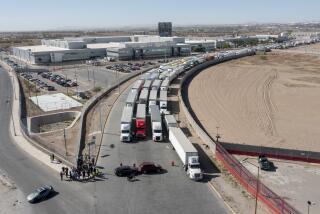Trade With Latin America: A Tale of Huge Numbers
Three issues dominate current U.S. policy toward Latin America: trade, drug trafficking and immigration. As President Clinton begins his second term, he would do well to give free trade within the Americas the highest priority. Numbers alone can provide a strong argument for that choice.
U.S. exports to its southern neighbors have grown at a remarkable pace in recent years, even though there are still too many tariffs and other trade barriers in Latin America. The value of those exports will exceed $100 billion in 1996. If this trend continues, the figure will rise to an staggering $240 billion annually by 2010, more than the current combined U.S. exports to Europe and Japan.
An export-oriented economy means not just higher profits for U.S. businesses but more jobs and better pay for American workers. Manufacture and exports of goods like electrical appliances, industrial machinery and automobiles require skilled labor that demands the highest wages.
The Clinton administration should take the lead in the move toward full regional economic integration. At the Miami Summit of the Americas in December 1994, the president proposed establishing a hemispheric free trade zone by 2005. The Mexican financial crisis later that month all but scuttled that recommendation, and this year’s U.S. presidential campaign gave rise to a few voices from America’s protectionist past, casting another shadow over the idea.
But Clinton would serve this country and its hemispheric neighbors well by picking up the banner of trade again. Mexico is climbing back to its feet, edging toward economic recovery--an accomplishment that should be credited in part to the strong foundation of the North American Free Trade Agreement. Safely reelected, Clinton could turn his attention to accepting an eager Chile under the NAFTA tent, bolstering the strength and stretch of the alliance.
Obviously the White House cannot achieve this independently. Congress should grant the president so-called “fast track” authority to negotiate a trade agreement with Chile. In July, the president must send Congress a report on NAFTA’s progress. There will be no better opportunity to try to convince remaining doubters of the trade alliance that the payoff for the United States is potentially high, both in NAFTA trade and developing a competitive edge for the global economy as a whole.
This is not to argue that the other issues on Clinton’s Latin American agenda are unimportant. But the emotional matters of drug trafficking and illegal immigration should not be allowed to become irritants to progress on trade, which, ultimately, can improve Latin American economies and thus diminish the pressures that drive these two problems. Some would argue that an economic boom south of the U.S. border would keep at home many job seekers who otherwise would illegally enter this country. It also might even convince some peasants that growing opium poppies, marijuana and coca is not worth the risk when weighed against the legal benefits of improved economies.
U.S.-Latin Trade
Trade figures for 1995, in billions:
*--*
Exp. Imp. Total Mexico $45.4 $62.7 $108.1 Brazil 11.4 9.4 20.8 Venezuela 4.6 10.4 15.0 Columbia 4.6 3.9 8.5 Dom. Rep. 3.0 3.5 6.5
*--*
Source: International Monetary Fund
More to Read
Sign up for Essential California
The most important California stories and recommendations in your inbox every morning.
You may occasionally receive promotional content from the Los Angeles Times.










